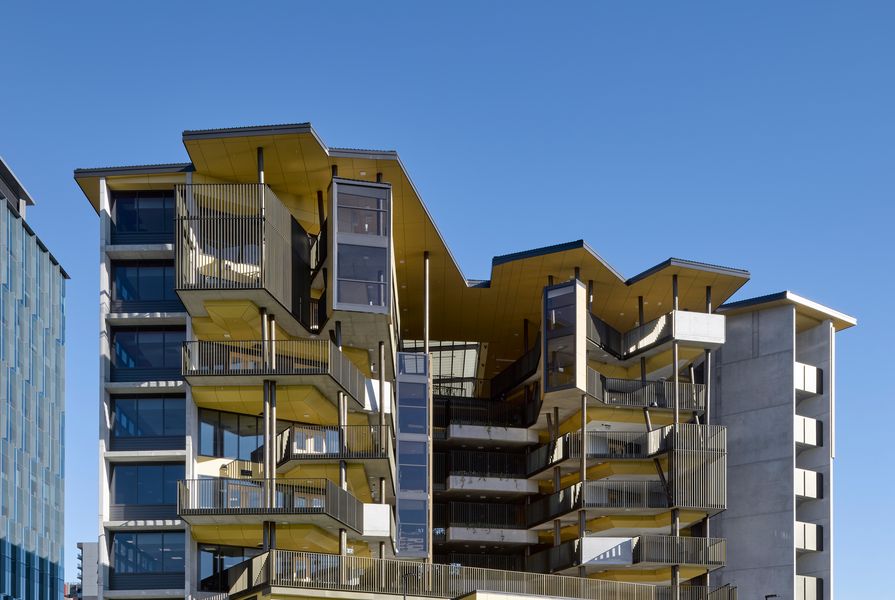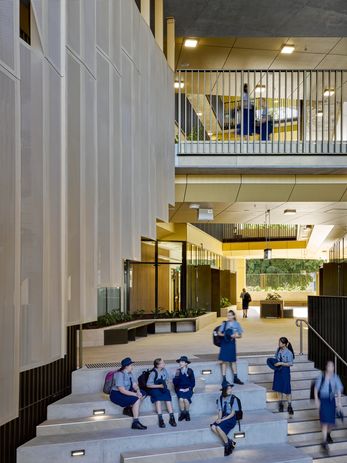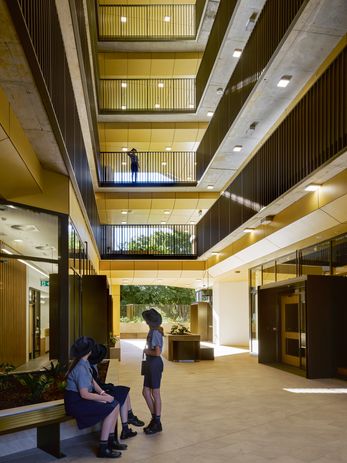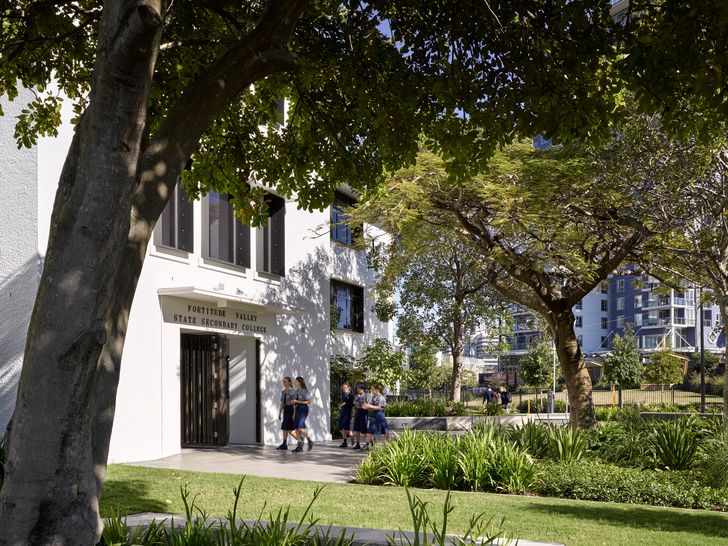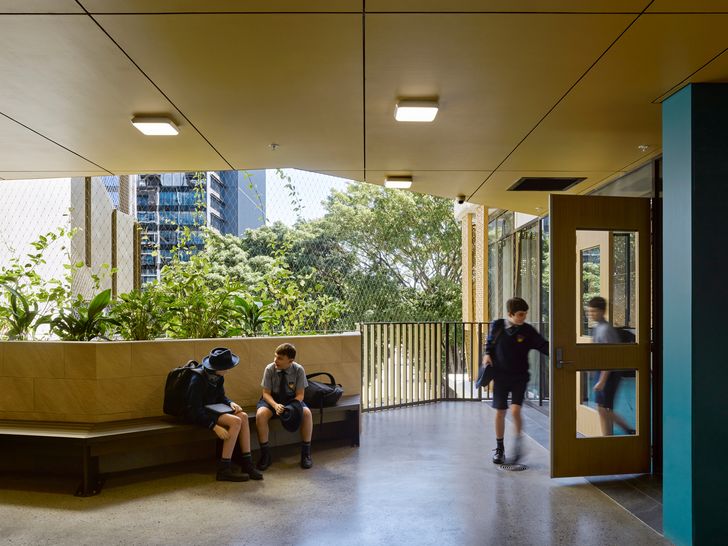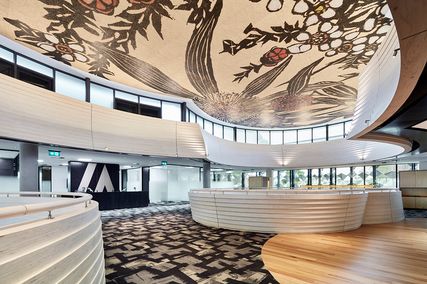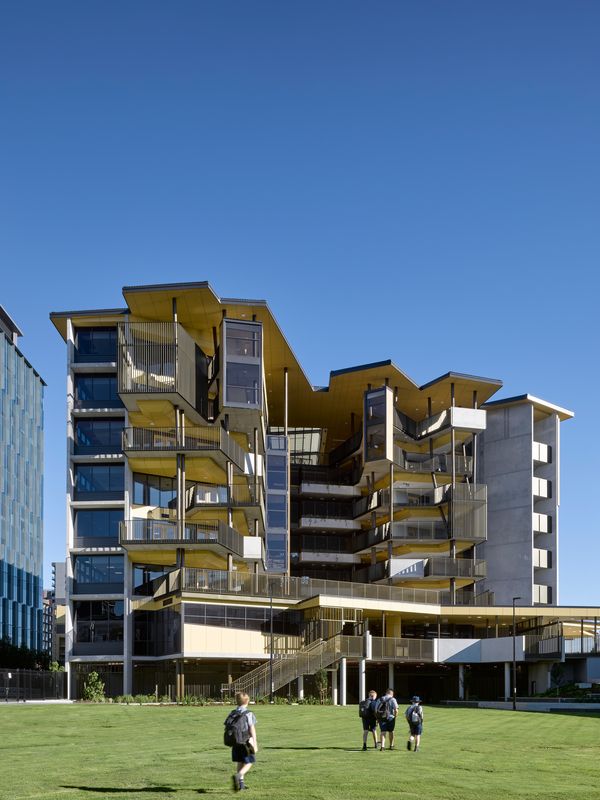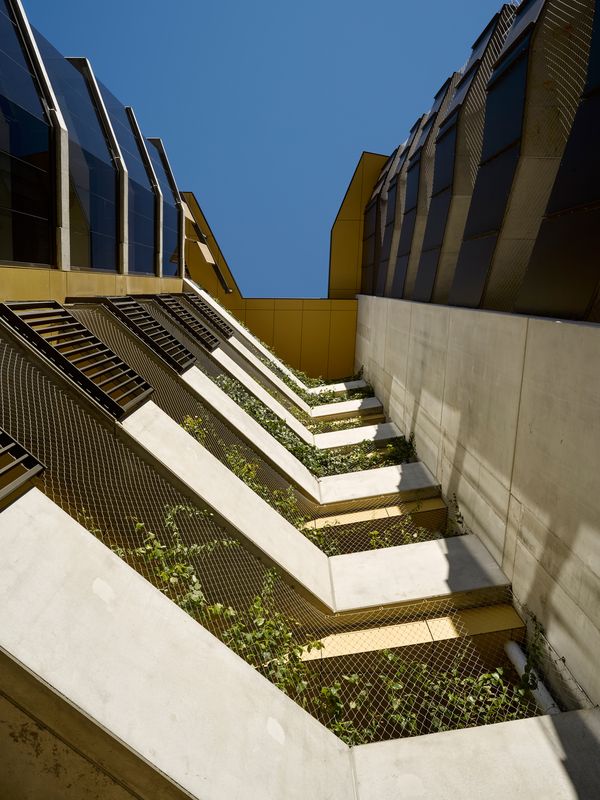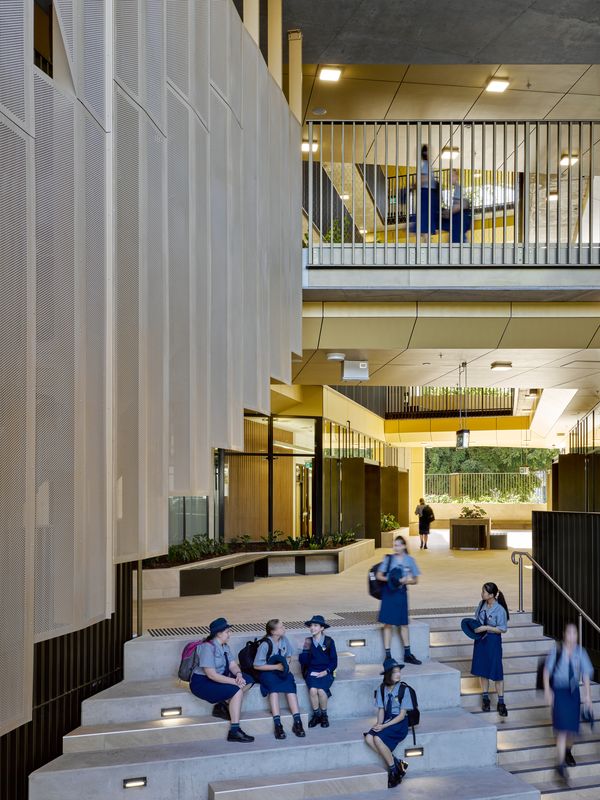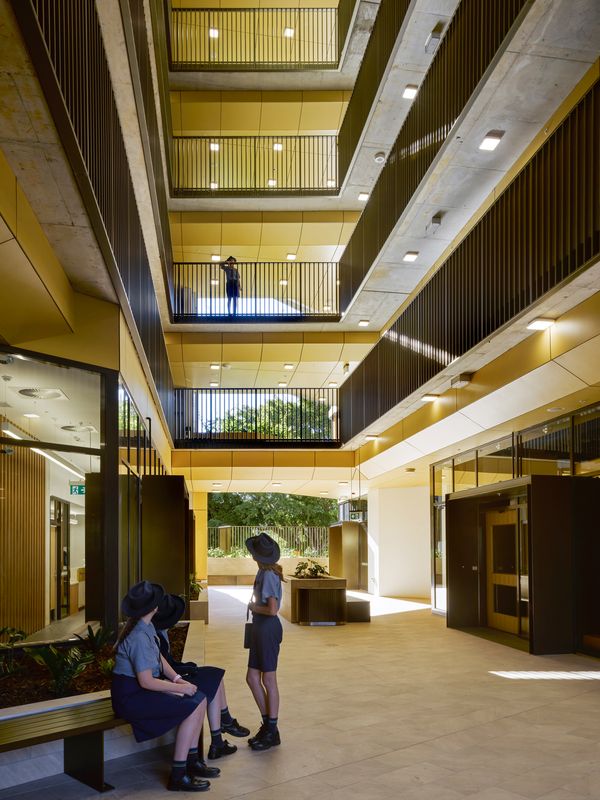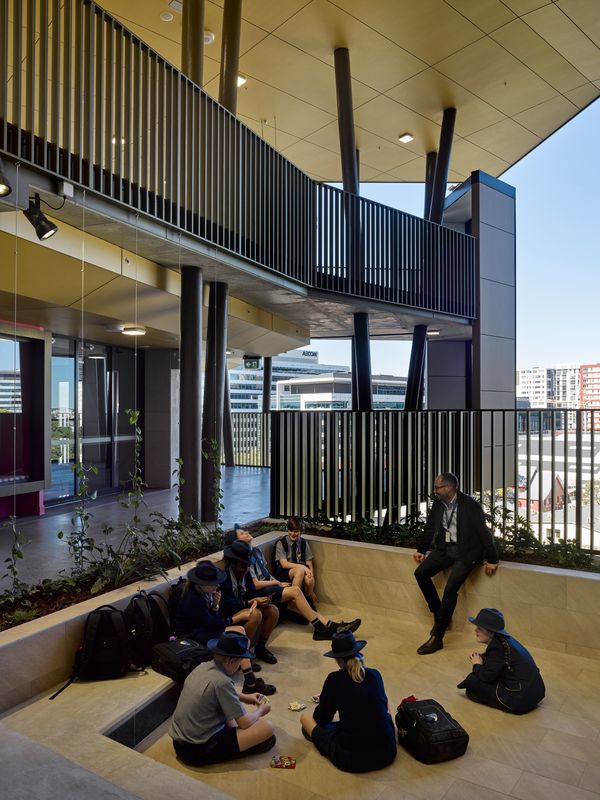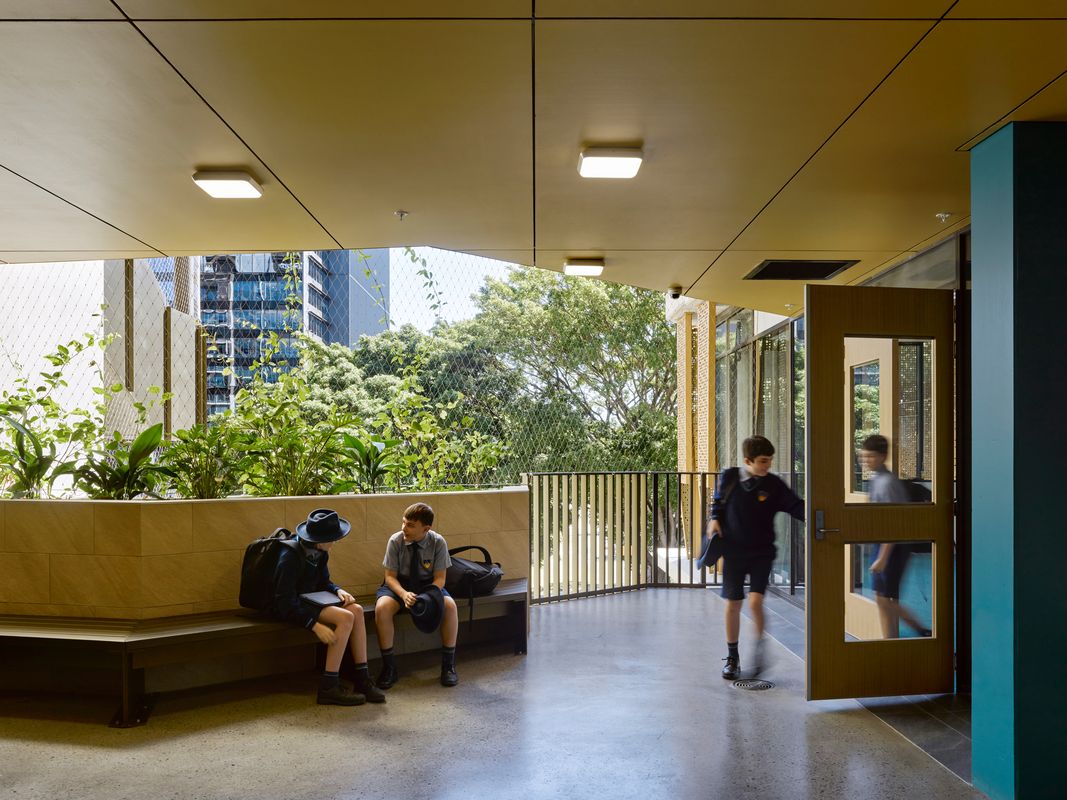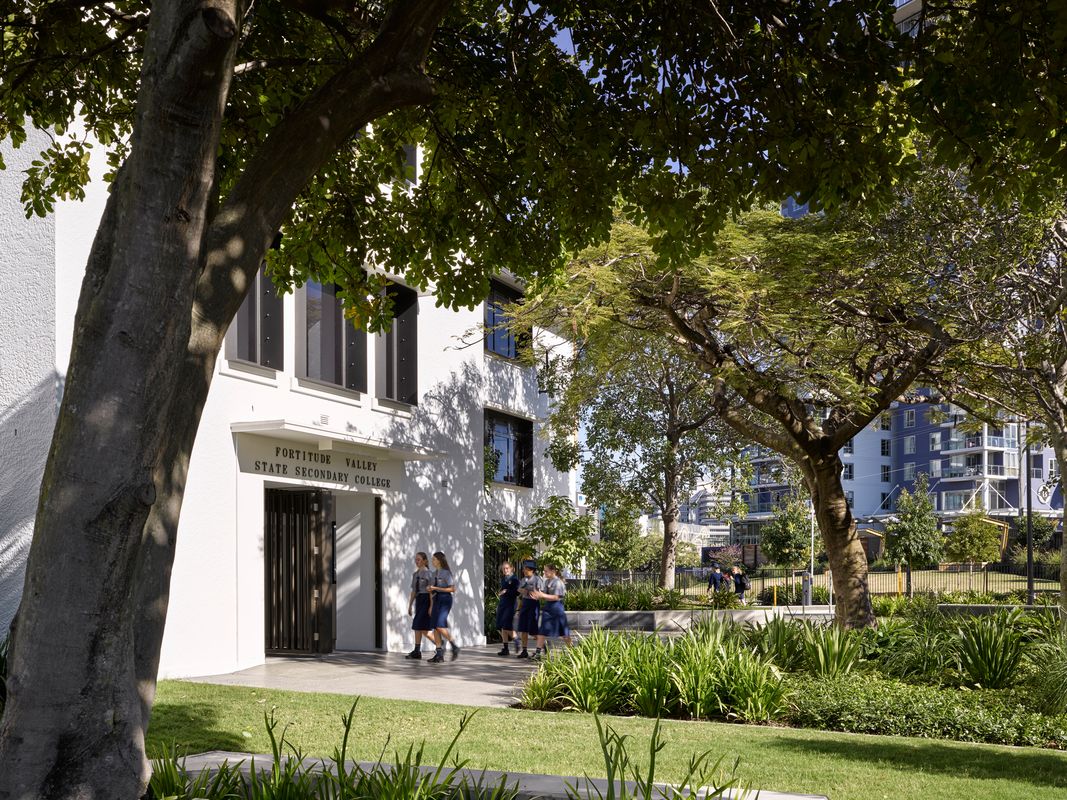Vertical schools, while familiar in other parts of the world, are still reasonably novel in Australia, particularly in the government school system. Increasingly, though, the typology is becoming relevant as more families opt to live in inner-city areas because of their proximity to work and lifestyle amenities. In Brisbane, as the dominance of high-value knowledge-intensive services further transforms the urban economy, significant urban renewal is driving greater residential density. In response, the Queensland state government has resourced the creation of two new vertical inner-city schools, one in Fortitude Valley in the inner north and the other in Dutton Park in the inner south.
The first of these two projects to get underway, Fortitude Valley State Secondary College, is also the first school to be built in Brisbane’s inner city in more than 50 years. It opened its doors to a foundation cohort of 150 junior students in January 2020 and by 2025 the college population is expected to grow to 1,500 students. The college is located on the grounds of the former Fortitude Valley State School, which was closed in 2013 along with several others across the state as part of a Liberal government scheme to sell off public assets. Until its closure, it was the longest-surviving state primary school in operation in Brisbane, with original buildings designed by Benjamin Backhouse and Richard Suter in 1867 and 1874. Although the school had subsequently moved (in 1950, into a three-storey building on the site of the new college), the nineteenth-century buildings – now heritage protected – are extant on the adjacent site and remain a significant influence on the area’s scale and streetscape.
The junior learning centre is characterized by a sense of openness, with views both close and distant.
Image: Christopher Frederick Jones
In 2015, the then-new Labor government (led by Annastacia Palaszczuk) reversed the plan to sell the Fortitude Valley site and retained the property in public hands. In 2017, the same government announced this site as the location for a new vertical school to be delivered in partnership with Queensland University of Technology (QUT) as the “flagship” project of a large-scale masterplanning, land acquisition and building scheme.
The new college has been designed by Cox Architecture and documented by Thomson Adsett. Prior to the design development stage, an intensive “enquiry by design” (EbD) process was facilitated by Urbis to distil the aspirational dimensions of the project, the novel typology and the challenges of the site into a conceptual framework. The EbD process, which involved a diverse group of participants from government, school leadership, QUT and the design team, generated a reference design that considered the physical constraints and opportunities of the urban campus, its broader precinct and approaches for maximizing the educational possibilities of the urban setting through community engagement and partnerships, student wellbeing and anticipative curriculum and pedagogy.
The design activates the interstitial space and expresses the school’s urban subtropical location.
Image: Christopher Frederick Jones
The site – bounded by Brookes Street and St Pauls Terrace (both busy roads), a four-track rail line and high-rise office buildings – sits at the northern limits of Fortitude Valley and within walking distance of a rich array of community, cultural, transport and sporting facilities. This primes the college’s innovative curriculum approach of the city as the campus, employing students’ direct experiences of the surrounding context as triggers for learning. Reciprocally, the college is also intended as a community resource beyond its core function of education. Striking a balance between accessibility, permeability and security, Cox’s masterplan establishes distinct buildings within connected college precincts (music and performing arts, junior school, sports centre and senior school), which are arranged to frame a green “oasis” as a focus of the constructed landscape. The college is being realized in stages and, at the time of writing, the music, performing arts and junior school buildings are complete while the second-stage senior school and sports centre are due for completion in 2023.
The existing 1950s building on Brookes Street has been repurposed as the music education building, after Cox persuasively argued against its demolition. With a forecourt of mature trees and a redesigned transitional undercroft, the building now serves as a symbolic and practical portal to the new, setting up connections at two levels to the adjoining performing arts centre. The flexible performing arts space, in turn, opens onto a terrace addressing the college green and views of the suburbs of Fortitude Valley and New Farm.
Cox argued for the retention of the existing 1950s building, which now serves as a portal to the new school.
Image: Christopher Frederick Jones
The terrace merges into a plaza that leads beneath bright connective canopies to the elevated ground plane of the “Barrambin” building, which takes up the north-west quadrant of the college grounds addressing St Pauls Terrace. Named for a nearby Aboriginal cultural heritage site, Barrrambin houses the junior secondary learning and teaching spaces and school administration over seven levels. This building is incredibly dynamic in the expression of its parti: rising from the elevated ground level (which hosts student services, an innovation hub, the library and the cafe) are a northern wing of general learning areas and a southern wing of specialized learning spaces. These two wings are profiled around a central atrium, splaying open and engaging views to the near landscape of the college green and broader views of the city beyond. As a result of this strategy, a prospective openness infuses the experience of being both in motion and at rest in the building; the only enclosed spaces are for formal learning, administration and engagement – and all of these have transparency back into the atrium and out to surroundings in all directions. On each typical floor, one finds open-space teaching areas, sunken outdoor learning courts and generous terraces that expand the spectrum of available learning environments. The open stairs, which are prominent and visible and climb the atrium above a broad-stepped outdoor learning terrace that connects down to the college green, are emblematic of the architects’ intention to demonstrably activate the interstitial space.
One of the core considerations of inner-urban vertical schools is the provision of outdoor space for learning and recreation.1 Cox’s commitment to an expression of urban subtropicality, represented in the positive formation of a variety of open spaces as an organizing principle for the college, not only achieves flexibility in the provision of places for learning but also promotes the health and wellbeing of the college community. Instead of the more typical school setting of horizontal circulation between dispersed low-rise classroom blocks, in Barrambin teachers and students are bonded in their use of the same grand stair throughout the day, their physical energy becoming social in these vertical transitions. There’s a jaunty positivity in the architectural celebration of both movement and repose as inhabitants climb and descend, taking up occupation of a variety of projecting terraces and protected courts that distinguish each level or travelling between Barrambin and other locations. All of this activity ebbs and flows beneath the distinctive outline of the oversailing roof, which is supported by idiosyncratically canted columns that appear to pierce through the floor plates.
The school’s curriculum approach encourages the students to see the whole city as their campus.
Image: Christopher Frederick Jones
The creation of any new learning environment is an opportunity for transformation: for change in teachers’ and students’ behaviour and for the establishment of new norms. The articulation and expression of the environment at its intersection with the design of curriculum and learning activities can make or break the complex aspirations of a school community, especially one that aims at meaningful transformation. In support of an optimistic and anticipative vision for their community of young learners, FVSCC teachers are implementing a novel and thoroughly integrated curriculum that engages the full range of learning opportunities surrounding the school.
Herman Hertzberger said of students’ experience, “It is important to have a view of everything so they can be inspired by everything.”2 When the architects describe Barrambin as a “treehouse,” they connect with this idea by offering learners an optimistic prospect throughout every school day, encouraging their curiosity and the sense that the entire city is their classroom.
1. Clare Newton, “Vertical schools on the rise in Australian cities,” Architecture Australia, Sept/Oct 2019, 86–91.
2. Adam Swinburn, Interview with Herman Hertzberger on Montessori College and vertical schools in “Vertical school design: Strategising the spatial configuration of a multi-storey typology to facilitate education in dense city environments,” Byera Hadley Travelling Scholarships Journal Series, 2017, 79, architects.nsw.gov.au/download/Vertical School Design_AdamSwinburn.pdf (accessed 27 October 2020).
Credits
- Project
- Fortitude Valley State Secondary College
- Architect
- Cox Architecture
Australia
- Project Team
- Spyros Barberis, Mitchell Buckley, Remy Chard, Christina Na-Heon Cho, Richard Coulson, Julian Farrell, Steven Harth, Alex Leiva, Anya Meng, Leon McBride, James Ryan, Mark Sierzchula, Brooke Lloyd, Jaegeun Lim, Casey Vallance
- Consultants
-
Acoustics, AV, ESD, services and vertical transport consultant
AECOM
Building certification and access consultant Philip Chun & Associates
Civil, facade, fire engineering, structure, traffic and wind consultant Arup
Client Queensland Department of Education
Documentation Thomson Adsett (Michael Bowman, Chad Brown, Blake Challen, Rebecca Holmes, Daniel Kalf, Bianca Di Luzio, Wesley Lee, Randal Williams)
Landscape consultant RPS Group
- Aboriginal Nation
- Built on the land of the Turrbal people.
- Site Details
-
Location
Fortitude Valley,
Brisbane,
Qld,
Australia
Site type Urban
- Project Details
-
Status
Built
Completion date 2020
Category Education
Type Schools
Source

Project
Published online: 28 Jan 2021
Words:
Sheona Thomson
Images:
Christopher Frederick Jones
Issue
Architecture Australia, January 2021

